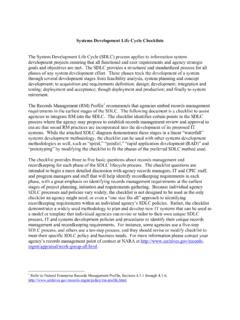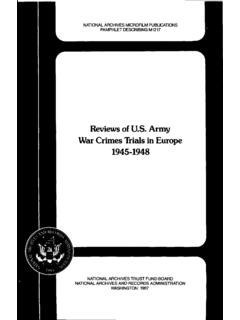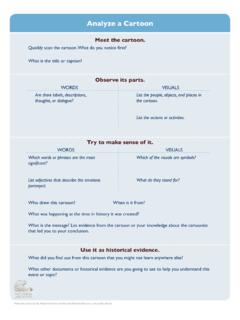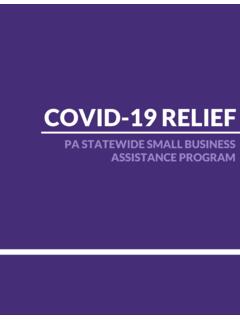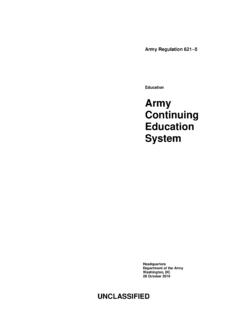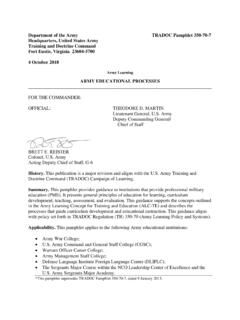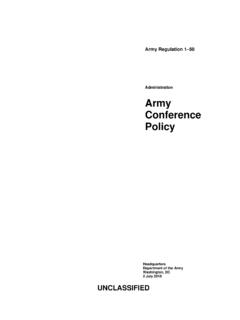Transcription of Version 1.1 – December 6, 2016 - Archives
1 1 Version December 6, 2016 As required by Executive Order 13556, Controlled Unclassified Information, November 4, 2010, and 32 CFR Part 2002, Controll ed Unclassified Information, effective November 14, 2016. CUI HANDBOOK 2016-12-06: This guidance document does not have the force and effect of law and is not meant to bind the public, except as authorized by law or regulation or as incorporated into a contract. Accordingly, with regard to the public, this document only provides clarity regarding existing requirements under the law or agency policies. This guidance document is binding on agency actions as authorized under applicable statute, executive order, regulation, or similar of Contents 2 Introduction .. 4 PART ONE: CUI M ARKINGS IN AN UNClASSlf lED :ENVIRONMENT - - 5 The CUI Banner M ar king .. 6 CUI Banner M arkings (CUI Control M ar kingl .. 7 CUI categories and Subcat ego r ies.)
2 8 Banner M arkings ( category or Subcat egory Marking) .. 9 1M arking CU ii Specified .. 10 Banner M arkings (Mult iple Cat egory or Subcate;gory M arking) .. 11 Banner M arkings (Limit ed Dissem ination Control s) .. 12 ion Ind icato r .. 13 Portion M .. 14 Portion M ar king CUI .. - -- 15 Portion M arkings (with category only) .. 16 Port ion M ar kings (with Category an d Dissem i natio n) .. 17 COMMON M ISTAKES (Category or Subcat egory Markings NOT in a Banner M ar king) .. 18 1M arking MuJtip le Pages .. 1 9 !Req uir ed Indicat or s per Autflor it ies .. 20 Supplemental Administrativ e M arkings .. 21 COMMON M ISTAKES (Supplem ental .Adm inistrat ive Mar kings} .. 22 M arking Electronic M edia Stor ing o r Proce~ing CUI .. 23 1M arking For ms witfl CUI - 24 CU I Cove rsheets.)
3 25 M a ricing Tra nsm itt a 11 Documents .. 26 AJte rnate M arkin g M et h ods .. 27 IRoom or Area Markings .. - - 28 Contai ner M arkings .. 29 Shipping and Mailing .. 30 :Re-M arking Legacy Inf or m ation .. 31 !Re-Marking Legacy Infor m ation .. 32 Table of Contents (con t.) 3 PART TWO: MARKINGS IN A CLASSIFIED ENVIRONMENT _____ -------- -------- -------- -------- -------- 3 3 M a ricing Com mingled Information .. ------- .. 3 4 Comminglirng - B,an ner Lin es _____ .. _____ .. _____ .. _____ .. _____ .. _____ .. _____ .. _____ .. _____ .. _____ .. 35 Comminglirng - Portion Markings .. 3 6 Commingjirng Examples ( 1). _____ .. _____ .. _____ .. _____ .. _____ .. _____ .. _____ .. _____ .. _____ .. 37 Comminglirng Examples ( 2l---- - ----- .. --- - ------.. ------- .. --- - ------.. - 38 Co mminglirng Examples (3 _____.))
4 _____ .. _____ .. _____ .. _____ .. _____ .. _____ .. _____ .. _____ .. 39 Co mminglirng Portion Marttng __ .. ----- - .. _____ .. _____ .. --------.. ------- .. _____ .. 40 Introduction The CUI Program standardizes the way the Executive branch handles unclassified information that does not meet the criteria required for classification under 13526, Classified National Security Information, December 29, 2009, or the Atomic Energy Act but must be protected based on law, regulation, or Government-wide policy. That protection involves the safeguards employed while being stored or handled by the Executive branch departments or agencies (hereafter referred to as agencies), as well as the controls involving how the information is disseminated. Prior to implementation of the CUI Program, agencies employed ad hoc, agency-specific policies, procedures, and markings to sa feguard and control this information, such as information that involves privacy, security, proprietary business interests, and law enforcement investigations.
5 This inefficient, confusing patchwork resulted in inconsistent marking and safeguarding of documents, led to unclear or unnecessarily restrictive dissemination policies, and created impediments to authorized information sharing. This handbook was developed to assist authorized holders by providing examples of correctly marked Controlled Unclassified Information (CUI). Markings alert holders to the presence of CUI and, when portion markings are used, identify the exact information or portion that needs protection. Markings can alert holders to any CUI dissemination and sa feguarding controls. While every marking situation is not reflected, this handbook provides basic marking guidelines for CUI, regardless of form. Employees must review their agency s CUI policy prior to marking any CUI. The handling of CUI must be in accordance with 13556, Controlled Unclassified Information, November 4, 2010, (hereafter referred to as the Order), 32 CFR Part 2002, supplemental guidance published by the CUI Executive Agent (EA), and all applicable EA-approved agency policy.
6 This handbook contains guidance on what each marking is, where and how to apply it, and which items are mandatory or optional (based on internal agency policy). All markings used are for illustration purposes only. This booklet does not contain CUI and may be reproduced without permission. 4 PART ONE: CUI MARKINGS IN AN UNCLASSIFIED ENVIRONMENT 5 CUI Category or Limited CUI Control Subcategory Marki ng Dissemination Marki ng (if required) Control Marki ng CONTROLLED or CUI//CATEGORIES /SUBCATEGORIES//DISSEM The CUI Banner Marking: The CUI Banner Marking The primary marking for all CUI is the CUI Banner Marking. This is the main marking that appears at the top of each page of any document that contains CUI. This marking is MANDATORY for all documents containing CUI. The content of the CUI Banner Marking must be inclusive of all CUI within the document and must be the same on each page.
7 The Banner Marking should appear as bold capitalized black text and be centered when feasible. The CUI Banner Marking may include up to three elements: The CUI Control Marking (mandatory ) may consist of either the word CONTROLLED or the acronym CUI. CUI Category or Subcategory Markings (mandatory for CUI Specified). These are separated from the CUI Control Marking by a double forward slash (//). When including multiple categori es or subcategori es in a Banner Marking, they must be alphabetized and are separated by a single forward slash (/). Limited Dissemination Control Markings. These are preceded by a double forward slash (//) to separate them from the rest of the CUI Banner Marking. Here is a sample of the CUI Banner Marking: NOTE: The above example uses the words CATEGORIES and SUBCATEGORIES as substitutes for CUI Category or Subcategory Markings and the word DISSEM as a substitute for a Limited Di ssemination Control Marking.
8 Consult the CUI Registry for actual CUI markings. Reference: 32 CFR (b) 6 CUI Banner Markings ( CUI Control Marking) The CUI Control Marking is mandatory for all CUI and may consist of either the word CONTROLLED or the acronym CUI (at the designator s discretion). As an optional best practice, the CUI Banner Marking may be placed at the bottom of the document as well. Below are two examples showing the options for the CUI Banner Marking. CONTROLLED department of Good Works Washington, 20006 CUI department of Good Works Washington, 20006 August 27, 2016 MEMORANDUM FOR THE DIRECTOR From: Elliott Alderson, Chief Robotics Divisi on Subj ect: Examples We su pport President Walken by ensuring that the Government protects and provides pr oper access to information to advance the national and public interest. We lead efforts to standardi ze and assess the management of classifi ed and controlled unclassifi ed information through oversight, policy development, guidance, education, and reporting.
9 CONTROLLED August 27, 2016 MEMORANDUM FOR THE DIRECTOR From: Tyrell Wellick Office of the CTO Subj ect: Examples We su pport President Walken by ensuring that the Government protects and provides pr oper access to information to advance the national and public interest. We lead efforts to standardi ze and assess the management of classifi ed and controlled unclassifi ed information through oversight, policy development, guidance, education, and reporting. CUI MANDATORY: CUI Banner Markin gs must appear on the top portion of the page. Optional Best Practice: Also Placed Centered at Bottom Reference: 32 CFR (b)(1) 7 CUI Categories and Subcategories A Bit About CUI Categories and Subcategories: The CUI Program is founded on the prerequisite that only information requiring protection based in a law, Federal regulation, or government-wide policy can qualify as CUI.
10 CUI Categories and Subcategories are essentially the different flavors of CUI. Each Category and Subcategory is based in at least one (and sometimes many) of these laws, regulations, or government-wide policies also referred to as Authorities that require a certain type of information to be protected or restricted in dissemination. There are two types of CUI Categories and Subcategories: CUI Basic and CUI Specified. CUI Basic is, as the name implies, the standard flavor of CUI. All of the rules of CUI apply to CUI Basic Categories and Subcategories, making the handling and marking of CUI Basic the simplest. CUI Specified is different, since the requirements for how users must treat each type of information vary with each Category or Subcategory. This is because some Authorities have VERY specific requirements for how to handle the type of information they pertain to requirements that simply would not make sense for the rest of CUI.


